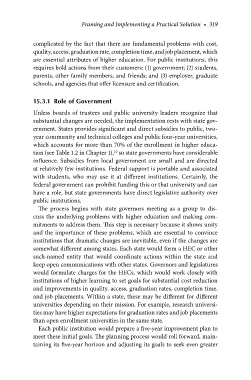Page 349 - Crisis in Higher Education
P. 349
Framing and Implementing a Practical Solution • 319
complicated by the fact that there are fundamental problems with cost,
quality, access, graduation rate, completion time, and job placement, which
are essential attributes of higher education. For public institutions, this
requires bold actions from their customers: (1) government; (2) students,
parents, other family members, and friends; and (3) employer, graduate
schools, and agencies that offer licensure and certification.
15.3.1 Role of Government
Unless boards of trustees and public university leaders recognize that
substantial changes are needed, the implementation rests with state gov-
ernment. States provides significant and direct subsidies to public, two-
year community and technical colleges and public four-year universities,
which accounts for more than 70% of the enrollment in higher educa-
10
tion (see Table 1.2 in Chapter 1), so state governments have considerable
influence. Subsidies from local government are small and are directed
at relatively few institutions. Federal support is portable and associated
with students, who may use it at different institutions. Certainly, the
federal government can prohibit funding this or that university and can
have a role, but state governments have direct legislative authority over
public institutions.
The process begins with state governors meeting as a group to dis-
cuss the underlying problems with higher education and making com-
mitments to address them. This step is necessary because it shows unity
and the importance of these problems, which are essential to convince
institutions that dramatic changes are inevitable, even if the changes are
somewhat different among states. Each state would form a HEC or other
such-named entity that would coordinate actions within the state and
keep open communications with other states. Governors and legislatures
would formulate charges for the HECs, which would work closely with
institutions of higher learning to set goals for substantial cost reduction
and improvements in quality, access, graduation rates, completion time,
and job placements. Within a state, these may be different for different
universities depending on their mission. For example, research universi-
ties may have higher expectations for graduation rates and job placements
than open enrollment universities in the same state.
Each public institution would prepare a five-year improvement plan to
meet these initial goals. The planning process would roll forward, main-
taining its five-year horizon and adjusting its goals to seek even greater

